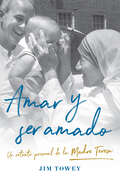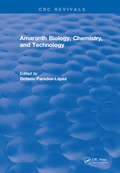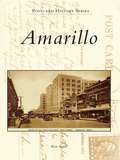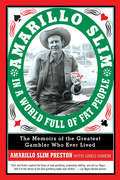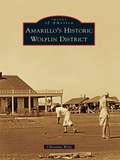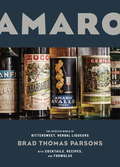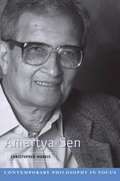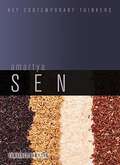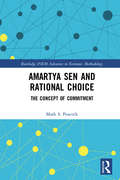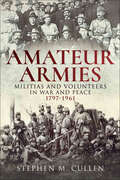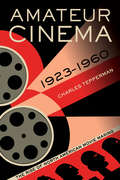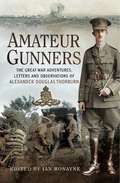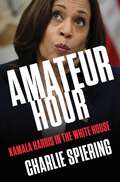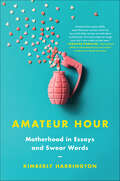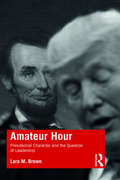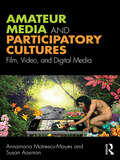- Table View
- List View
Amar y ser amado / To Love and Be Loved
by Jim ToweyDe manos de un consejero de confianza y devoto amigo de la Madre Teresa, tenemos un extraordinario recuento de primera mano de la milagrosa mujer detrás de la santa. Incluye imágenes hasta ahora desconocidas de la Madre Teresa. La Madre Teresa fue una de las mujeres más admiradas del siglo XX, y su recuerdo sigue inspirando labores caritativas por todo el mundo. Ella creía que la más grande necesidad de un ser humano era amar y ser amado. En 1948 fundó los Misioneros de la Caridad para trabajar directamente con los más pobres de Calcuta. A consecuencia del esfuerzo de una mujer adentrándose por los barrios bajos de Entally, los Misioneros de la Caridad crecieron hasta convertirse en una organización que operaba comedores, clínicas, hospicios y albergues en 139 países, sin ningún costo para el gobierno ni para quienes atendía. En 2016 se convirtió en Santa Teresa de Calcuta. El autor Jim Towey fue abogado y funcionario de alto rango en el Congreso de Estados Unidos en la década de 1980, hasta que un breve encuentro con la Madre Teresa iluminó el vacío de su vida. Se ofreció como voluntario en uno de sus comedores y usó sus habilidades legales y sus conexiones políticas para ayudar a los Misioneros de la Caridad. Cuando la Madre Teresa sugirió que cubriera algunos turnos en su hospicio para enfermos de SIDA, Towey descubrió el alcance de su propia vocación. Pronto dejó su trabajo y sus posesiones, y se convirtió en voluntario de tiempo completo para la Madre Teresa. Viajó frecuentemente con ella, acordando sus reuniones con políticos y manejando muchos de sus asuntos legales. Amar y ser amado es un recuento directo de los últimos años de la Madre Teresa y el primer libro en detallar su relación con los asuntos mundanos. La vemos navegar con gracia las oportunidades y los retos del liderazgo, los peligros de lafama, lo mismo que las humillaciones y los triunfos de envejecer. También la observamos disfrutando un helado de chocolate, haciendo bromas sobre las minifaldas y diciéndole al presidente de Estados Unidos que se equivoca. Por encima de todo, vemos su extraordinaria devoción a Dios y los más pobres de Sus hijos. La Madre Teresa le enseñó a Towey a orar más, a ser menos egoísta, más humilde, menos frívolo, a amar más a Dios y menos a sí mismo. Sus enseñanzas están aquí para todos.
Amaranatha Jha
by Hetukar JhaOn the life and works of Amaranatha Jha, 1897-1955, Maithili and Urdu author.
Amaranth Biology, Chemistry, and Technology
by Octavio Paredes-LopezThis book is devoted to amaranth, a plant to which 45 species are indigenous to the Mesoamerican region and 10 others originated in Africa, Asia, and Europe. Amaranth was the foundation of the extensive North and South American ancient civilizations and is still important in the agriculture of more recent Indian cultures. However, this plant nearly disappeared after the Spanish conquest. In view of the outstanding agronomic performance of the plant and the high nutritional value of the grain, it is now becoming an important crop in various regions of the world. Progress in the utilization of amaranth is directly related to scientific and technical information on its biological, physical, and chemical properties. Amaranth: Biology, Chemistry, and Technology begins with a chapter on the use of tissue culture, molecular biology, and genetic engineering techniques for crop improvement. The next few chapters deal with classical genetics, traditional plant breeding, and plant physiology. Following chapters review the properties of storage and leaf proteins, carbohydrates (especially starch), and seed oil. The potential of amaranth for new food products and popping is discussed, and commercialization and marketing of amaranth and its products are described. The book also emphasizes the outstanding nutritional properties of amaranth.
Amaranthus: A Promising Crop of Future
by Saubhik DasThis book serves the larger community of plant researchers working on the taxonomy, species delimitation, phylogeny, and biogeography of pseudo-cereals, with a special emphasis on amaranths. It also provides extensive information on the nutritive value of underutilized pseudo-cereals, the goal being to broaden the vegetable list. Amaranthus is a cosmopolitan genus of annual or short-lived perennial plants. Most of the species are summer annual weeds and are commonly referred to as pigweed. Only a few are cultivated as vitamin-rich vegetables and ornamentals. The protein-rich seeds of a handful of species, known as grain amaranths, are consumed as pseudo-cereals. Amaranthusmanifests considerable morphological diversity among and even within certain species, and there is no general agreement on the taxonomy or number of species. Currently the genus Amaranthus is believed to include three recognized subgenera and 70 species. Amatanthus is considered to potentially offer an alternative crop in temperate and tropical climate. The classification of amaranths is ambiguous due to the lack of discrete and quantitative species-defining characteristics and the wide range of phenotypic plasticity, as well as introgression and hybridization involving weedy and crop species. It is a known fact that both vegetable and grain amaranths have evolved from their respective weed progenitors. There are more than 180 different weed species that are herbicide-resistant, and amaranths are considered to be leading members of the resistant biotypes. Amaranth species provide ample scope for investigating herbicide resistance mechanisms. Amaranths also show variability in terms of their mating behavior and germplasm, adaptability to different growing conditions, and wide range of variability in sexual systems, from monoecy to dioecy. A solid grasp of these parameters is essential to the future utilization of amaranths as super crops. There are quite a few amaranth research center and germplasm collections all over the world that maintain and evaluate working germplasms. To date, the genetic improvement of amaranths has primarily involved the application of conventional selection methods. But advances in genomics and biotechnology have dramatically enriched the potential to manipulate the amaranth genome, especially improving the amount and availability of nutrients. In conclusion, the book covers all aspects of amaranths, including their food value, significance as vegetables and pseudo-cereals, taxonomy, phylogeny, germplasm variability, breeding behavior and strategies, cultivation practices, and variability in terms of their sexual systems. It offers a valuable resource for all students, researchers and experts working in the field of plant taxonomy and diversity.
Amarcord
by Marcella HazanWidely credited with introducing proper Italian food to the English-speaking world, Marcella Hazan is known as America's godmother of Italian cooking. Raised in Cesentatico, a quiet fishing town on the northern Adriatic Sea, she'd eventually have her own cooking schools in New York, Bologna, and Venice, where she would teach students from around the world to appreciate-and produce-the homemade pasta, rustic soups, deeply satisfying roasts and stews, pure seafood dishes, and the fresh vegetables dressed with olive oil that Italians eat. She'd write bestselling and award-winning cookbooks, and collect invitations to cook at top restaurants around the world. She would have thousands of loyal students, and readers so devoted they'd name their daughters Marcella. Her fans will be as surprised and delighted b how all this came to be as Marcella herself has been. Marcella's story begins not in Italy but in Alexandria, Egypt, where she spent her early childhood and where she fell on the beach and broke her arm-an accident that would hardly register for a child today, but which altered the course of her life. After nearly losing her arm to poor medical treatment, she was taken back to her father's native Italy for surgery. There the family would remain. Her teenage year coincided with World War II and the family relocated temporarily to Lake Garada, which they, not they, not anticipating that it would become one of war's greatest targets when both Mussolini and German High Command established their headquarters there, thought would be a safe haven. After years of privation and nightly bombings, Marcella was finally Fulfilling her ambition to become a doctor and professor of science when she Victor, the love of life. After their marriage, they moved to America, where Marcella knew not a word of English or-what's more surprising-a single recipe. She began to recall and attempt to re-create the flavours of her homeland. After women with whom she took a Chinese cooking class in the early sixties asked her to teach them Italian cooking, she began to give them lessons in her tiny New York kitchen. Soon after, Craig Claiborne invited himself to lunch, and the rest is history. Amacord means 'I remember' in Marcella's native Romangolo dialect. In these pages, Marcella, now eighty-four, looks back on the adventures of a life lived for pleasure and a love of teaching. Throughout, she entertains the reader with stories of the humorous, sometimes bizarre, twists and turns that brought her love, fame, and a change to forever change the way we eat.
Amarillo
by Ron SmithMany people are surprised to learn that the city of Amarillo was actually founded twice. Originally settled by J. T. Berry in April 1887 and known as Oneida, the site of the town was located on such low ground that many residents feared it was susceptible to flooding. In 1888, one concerned resident named Henry B. Sanborn began buying land a mile east of the site as a potential place to relocate the town. In 1889, the town's fears came to fruition when heavy rains flooded the original town site, prompting residents to move to Sanborn's new location. The town went on to become one of the world's busiest cattle shipping points in the late 1890s, causing its population to grow significantly. Today Amarillo is the largest city in the Texas Panhandle, and its economy continues to thrive on cattle, along with agriculture, oil, and natural gas.
Amarillo Slim in a World Full of Fat People
by Amarillo Slim PrestonThomas Austin Preston. Six foot four, skinny as a rake. He's played poker with two US presidents - and drug lord Pablo Escobar; made a million dollars by the age of nineteen; and driven a golf ball a mile. Thomas Austin Preston - who is he? The world knows him better as the greatest gambler of all time: Amarillo Slim. Raised in Amarillo, Texas, Amarillo Slim has lived the most daring, exciting and profitable life of any man alive. Sent overseas just after World War II to give billiards exhibitions for the US army, he ended up running the biggest black-market operation in Europe. Back home, he returned to his first love, cards, and won the World Series of poker in 1972. Now a living legend and member of four Halls of Fame, he's been celebrated in songs and movies, and his picture hangs in City Hall, Las Vegas. Because, most of all, Slim's a man who loves to gamble. He'll bet on anything - if the price is right. He's ridden a camel thourgh the fanciest casino in Marrakesh and beaten Evel Knieval at golf (with a hammer), but that was just the small stuff. In his finest hour, he took on the Chinese table tennis champion at his own game. Slim, of course, got to choose the bats. The choice? Coke bottles. The result? 21-0, 21-0, 21-0. Slim was a very happy man. In the most entertaining book this year, Amarillo Slim will tell you the story of his extraordinary life - and the secrets of his even more extraordinary success. From Vegas to Colombia, Texas to London, welcome to the wonderful world of Amarillo Slim!
Amarillo Slim's Play Poker to Win: Million Dollar Strategies from the Legendary World Series of Poker Winner
by Amarillo Slim PrestonIn this new and completely revised edition, the first reigning World Series of Poker Champion gets down and dirty about how to win big. It's not just about cards. It's about the people who hold them, so you'll need to be a master of human nature.Who better to teach you than American folk hero and gambling legend Amarillo Slim? Get his first-hand secrets on everything from counting cards to judging opponents, the laws of probability, betting, bluffing, when to drop, and when to pick up your chips and head home.
Amarillo's Historic Wolflin District
by Christine WylyIn September 1887, J. T. Berry bought 640 acres of school land from the State of Texas. Several years earlier, this raw section of prairie had been home to buffalo herds and the Kiowa and Comanche Nations. Berry could not have known that this land would one day become home to cattle barons, oil and gas pioneers, and a U.S. ambassador. When Charles Oldham Wolflin married Alpha Eunice McVean a decade later and acquired that same section of land, he never dreamed that his son would develop that land from a dairy farm into a premier residential development. Today the Wolflin Historic District is a vibrant, lush neighborhood with tree-lined brick streets and stately houses. It is home to several thousand residents, including descendants of pioneer families, modern-day professionals, and public servants who contribute to the arts, are involved in philanthropy, and are active in community service.
Amaro: The Spirited World of Bittersweet, Herbal Liqueurs, with Cocktails, Recipes, and Formulas
by Brad Thomas ParsonsThe European tradition of making bittersweet liqueurs--called amari in Italian--has been around for centuries. But it is only recently that these herbaceous digestifs have moved from the dusty back bar to center stage in the United States, and become a key ingredient on cocktail lists in the country's best bars and restaurants. Lucky for us, today there is a dizzying range of amaro available--from familiar favorites like Averna and Fernet-Branca, to the growing category of regional, American-made amaro. Amaro is the first book to demystify this ever-expanding, bittersweet world, and a must-have for any home cocktail enthusiast or industry professional. Starting with a rip-roaring tour of bars, cafés, and distilleries in Italy, amaro's spiritual home, Brad Thomas Parsons--author of the James Beard and IACP Award-winner Bitters--will open your eyes to the rich history and vibrant culture of amaro today. With more than 100 recipes for amaro-centric cocktails, DIY amaro, and even amaro-spiked desserts, you'll be living (and drinking) la dolce vita.From the Hardcover edition.
Amartya Sen
by Christopher W. MorrisAmartya Sen was awarded the Nobel Memorial Prize in Economics in 1998 "for his contributions in welfare economics." Although his primary academic appointments have been mostly in economics, Sen is also an important and influential social theorist and philosopher. His work on social choice theory is seminal, and his writings on poverty, famine, and development, as well his contributions to moral and political philosophy, are important and influential. Sen's views about the nature and primacy of liberty also make him a major contemporary liberal thinker. This volume of essays on aspects of Sen's work is aimed at a broad audience of readers interested in social theory, political philosophy, ethics, public policy, welfare economics, the theory of rational choice, poverty, and development. Written by a team of well-known experts, each chapter provides an overview of Sen's work in a particular area and a critical assessment of his contributions to the field.
Amartya Sen (Key Contemporary Thinkers)
by Lawrence HamiltonAmartya Sen is one of the world’s best-known voices for the poor, the destitute and the downtrodden and an inspiration for policy makers and activists across the globe. He has also contributed almost without peer to the study of economics, philosophy and politics, transforming social choice theory, development economics, ethics, political philosophy and Indian political economy, to list but a few. <P><P> This book offers a much-needed introduction to Amartya Sen’s extraordinary variety of ideas. Lawrence Hamilton provides an excellent, accessible guide to the full range of Sen’s writings, contextualizing his ideas and summarizing the associated debates. In elegant prose, Hamilton reconstructs Sen’s critiques of the major philosophies of his time, assesses his now famous concern for capabilities as an alternative for thinking about poverty, inequality, gender discrimination, development, democracy and justice, and unearths some overlooked gems. Throughout, these major theoretical and philosophical achievements are subjected to rigorous scrutiny.
Amartya Sen and Rational Choice: The Concept of Commitment (Routledge INEM Advances in Economic Methodology)
by Mark S. PeacockAre human beings motivated exclusively by self-interest? The orthodox theory of rational choice in economics thinks that they are. Amartya Sen disagrees, and his concept commitment is central to his vision of an alternative to mainstream rational choice theory. This book examines commitment as it has evolved in Sen's critique of orthodox rational choice theory. The in-depth focus on commitment reveals subtleties in the concept itself as well as in its relationships with other concepts which Sen develops in his critique of rational choice theory, for example preference, sympathy, weakness of will, agency, personhood, social norms, rights, self-welfare goal and self-goal choice. The book provides a comprehensive understanding of commitment and offers novel interpretations of the term as a way of strengthening its plausibility. Broadly in support of Sen’s conceptualization of rational choice, the book nevertheless reveals ambiguities and weaknesses in Sen’s conceptual framework, and it reformulates Sen’s concepts when doing so strengthens the claims he makes. The book also engages with critics of Sen and argues for the importance of commitment as a component in the theory of rational choice.
Amaruka
by N. P. UnniOn the life and works of Amaru, a Sanskrit poet, including his depiction of love in his poetry.
Amateur Armies: Militias and Volunteers in War and Peace, 1797–1961
by Stephen M. CullenA history of volunteer armies spanning from the French Revolutionary Wars and the War of 1812 to pre-1914 Ireland and the Bay of Pigs.Amateur Armies examines the military and social history of volunteer armies around the western world from the failed French invasion of South Wales in 1797 to the disastrous anti-Communist invasion of the Bay of Pigs in Cuba in 1961.It brings together some fascinating military actions across more than a century and a half of history and explores the social and political context in the countries involved. Stephen Cullen’s absorbing and original book is the first general survey of the role of amateur armies during the period.Included are chapters on a series of wars in which militias played critical parts. In each case, their actions and effectiveness are described as is the background from which they came, and the social and political circumstances in which they operated. This pioneering study offers a valuable insight into each of the amateur armies covered and opens up an important and hitherto neglected aspect of military history.
Amateur Cinema
by Charles TeppermanFrom the very beginning of cinema, there have been amateur filmmakers at work. It wasn't until Kodak introduced 16mm film in 1923, however, that amateur moviemaking became a widespread reality, and by the 1950s, over a million Americans had amateur movie cameras. In Amateur Cinema, Charles Tepperman explores the meaning of the "amateur" in film history and modern visual culture. In the middle decades of the twentieth century--the period that saw Hollywood's rise to dominance in the global film industry--a movement of amateur filmmakers created an alternative world of small-scale movie production and circulation. Organized amateur moviemaking was a significant phenomenon that gave rise to dozens of clubs and thousands of participants producing experimental, nonfiction, or short-subject narratives. Rooted in an examination of surviving films, this book traces the contexts of "advanced" amateur cinema and articulates the broad aesthetic and stylistic tendencies of amateur films.
Amateur Cinema: The Rise of North American Moviemaking, 1923-1960
by Charles TeppermanFrom the very beginning of cinema, there have been amateur filmmakers at work. It wasn’t until Kodak introduced 16mm film in 1923, however, that amateur moviemaking became a widespread reality, and by the 1950s, over a million Americans had amateur movie cameras. In Amateur Cinema, Charles Tepperman explores the meaning of the "amateur" in film history and modern visual culture. In the middle decades of the twentieth century—the period that saw Hollywood’s rise to dominance in the global film industry—a movement of amateur filmmakers created an alternative world of small-scale movie production and circulation. Organized amateur moviemaking was a significant phenomenon that gave rise to dozens of clubs and thousands of participants producing experimental, nonfiction, or short-subject narratives. Rooted in an examination of surviving films, this book traces the contexts of "advanced" amateur cinema and articulates the broad aesthetic and stylistic tendencies of amateur films.
Amateur Gunners: The Great War Adventures, Letters and Observations of Alexander Douglas Thorburn
by Ian RonayneAfter training at St John's Wood in London and in Exeter, Alexander Douglas Thorburn was posted to the BEF in France, joining the 2/22nd London (Howitzer) Battery, Royal Field Artillery as a subaltern officer. After service in the Vimy Ridge sector, with his division, the 60th (2/2nd London) Division, he crossed the Mediterranean to join the British Army in Salonika. Following a further move in mid-1917, Thorburn arrived in Palestine where he saw service with the 74th (Yeomanry) Division during the advance on Jerusalem. A final move in 1918 took the now Captain Thorburn back to the Western Front to take part in the Advance to Victory during the closing months of the war. After the war, Thorburn wrote an account of his military service between 1916 and 1918, recording his experiences in France, Greece and Palestine as well as his initial training in England. He also wrote a series of observations on life as a gunner during the First World War. Both the account and observations were published as a book, Amateur Gunners, in 1933 by William Potter of Liverpool. Today, the book is out of print. In addition to the book, of which a small number of copies still exist of course, there are an extensive series of private letters written by Thorburn while on active service to his mother, father and other relatives. The letters are in the possession of Thorburn's only grandson. Together, the book and letters offer a fascinating insight into the life of a First World War artillery officer. Lucidly written in a candid style, Thorburn shows excellent observation, description and narration skills. While Amateur Gunners itself is worthy of reprint, when combined with Thorburn's private letters and historical context from author Ian Ronayne, this book offers a unique look at a gunner's experience during the Great War.
Amateur Hour: Kamala Harris in the White House
by Charlie SpieringThe ultimate, comprehensive investigation into the life and career of Vice President Kamala Harris from former Washington Examiner and Breitbart News political reporter Charlie Spiering.Who is the real Kamala Harris? And how did she ascend to the second highest office in the country? Despite her limited experience in national politics and confusing professional history, there hasn&’t been a comprehensive examination of Vice President Kamala Harris&’s journey to the White House...until now. Find out how the San Francisco socialite turned politico fast-tracked her way onto the national stage, only to lose the faith of her base and her president. With exclusive reporting and a detective&’s eye, Charlie Spiering delivers the first-ever deep dive into Kamala Harris&’s hilarious, incompetent, radical path to the vice presidency. From her tumultuous tenure as California prosecutor to the fiery interrogator in the United States Senate, then to her disastrous presidential campaign and finally, her calamitous first years in executive office, this is an unfettered look at the woman who is only one heartbeat away from leading the free world.
Amateur Hour: Motherhood in Essays and Swear Words
by Kimberly Harrington“Kimberly Harrington deftly and hilariously uncovers all of the lies and bullshit women are told about motherhood. This book made me laugh, sure, but it also made me feel seen.” — Jennifer Romolini, chief content officer at Shondaland.com and author of Weird in a World That’s NotAn emotionally honest, arresting, and funny collection of essays about motherhood and adulthood.“Being a mother is a gift.”Where’s my receipt?Welcome to essayist Kimberly Harrington’s poetic and funny world of motherhood, womanhood, and humanhood, not necessarily in that order. It’s a place of loud parenting, fierce loving, too much social media, and occasional inner monologues where timeless debates are resolved such as Pro/Con: Caving to PTO Bake Sale Pressure (“PRO: Skim the crappiest brownies for myself. CON: They’re really crappy.”) With accessibility and wit, she captures the emotions around parenthood in artful and earnest ways, highlighting this time in the middle—midlife, the middle years of childhood, how women are stuck in the middle of so much. It’s a place of elation, exhaustion, and time whipping past at warp speed. Finally, it’s a quiet space to consider the girl you were, the mother you are, and the woman you are always becoming.
Amateur Hour: Presidential Character and the Question of Leadership
by Lara M. BrownThis book assesses the impact of presidential character on the popularity, productivity, and ethics of contemporary presidents. Through comparative analyses, author Lara Brown demonstrates that the character of a president’s leadership does not change in office and that the success of future presidents can be evaluated before they step into the White House. She traces the rise of “amateur outsiders,” like Donald Trump, and asserts the need for systemic reform and cultural reassessment of presidential character. Intended for students and scholars of the presidency, this book also holds appeal for general readers who seek understanding of past and future presidential elections.
Amateur Media and Participatory Cultures: Film, Video, and Digital Media
by Susan Aasman Annamaria Motrescu-MayesAmateur Media and Participatory Cultures aims to delineate the boundary line between today’s amateur media practice and the canons of professional media and film practice. Identifying various feasible interpretative frameworks, from historical to anthropological perspectives, the volume proposes a critical language able to cope with amateur and new media’s rapid technological and interpretative developments. Conscious of the fact that amateur media continue to be seen as the benchmark of visual records of authentic rather than mass-media-derived events, Annamaria Motrescu-Mayes and Susan Aasman pay particular attention to the ways in which diverse sets of concepts of amateur media have now merged across global visual narratives and everyday communication protocols. Building on key research questions and content analysis in media and communication studies, they have assessed differences between professional and amateur media productions based on the ways in which the ‘originators’ of an image have been influenced by, or have challenged, their context of production. This proposes that technical skills, degrees of staging and/or censoring visual information, and patterns in media socialisation define central differences between professional and amateur media production, distribution and consumption. The book’s methodical and interdisciplinary approach provides valuable insights into the ways in which visual priming, cultural experiences and memory-building are currently shaped, stored and redistributed across new media technologies and visual channels.
